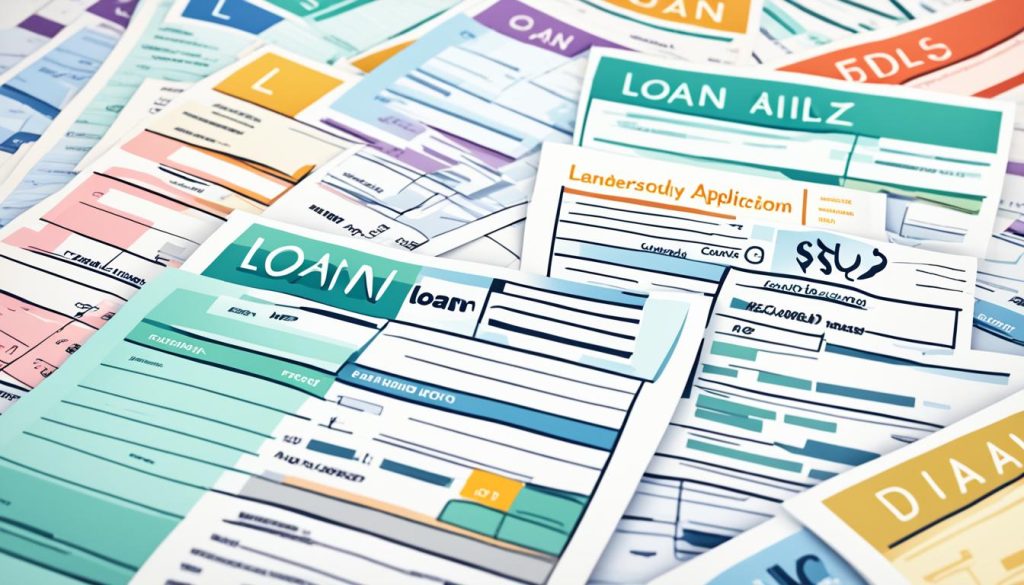Refinancing a personal loan can save you money on interest or lower your monthly payments. It means getting a new loan to replace your old one, either from the same lender or a new one. You use the new loan to pay off the old one, then pay back the new loan monthly. It’s a good idea when your current loan’s interest rate or payments are higher than what you could get with a new loan1.
- Refinancing personal loans typically involves interest rates ranging from 6.99% to 35.99% APR.
- Lenders like Upgrade, LightStream, SoFi, PenFed, Discover, Wells Fargo, and Best Egg offer refinancing with APRs between 7.49% and 29.99%.
- Refinancing can extend repayment terms, allowing for lower monthly payments and financial flexibility.
- Shortening the loan term through refinancing can reduce total interest costs and clear debt sooner.
- Additional fees, such as origination fees, should be considered when deciding to refinance.
Understanding Loan Refinancing
What Does It Mean to Refinance a Loan?
Refinancing a personal loan means getting a new one to replace the old one. This new loan might have a lower interest rate or a different repayment plan2. People refinance to get better loan terms, like a smaller monthly payment or a shorter loan period2. The most common type is rate-and-term refinancing, aiming for a lower interest rate or a changed loan term2.
There are other types of refinancing too. Cash-out refinancing lets you take out a bigger loan and get cash, often for home improvements or other big expenses3. Cash-in refinancing lets you pay off part of the loan, which might lower your interest rate or monthly payment3. Consolidation refinancing can also lead to much lower interest rates2.
Refinancing can offer lower monthly payments and interest rates2. But, it might mean paying more interest over the loan’s life2. Companies can also refinance to manage their finances better2.
For personal loans, refinancing can mean getting lower interest rates, changing your mortgage terms, or getting cash from your home’s equity2. The process involves swapping the old mortgage for new terms, like a different loan amount and interest rate2. Even though refinancing can lower your credit score at first, it can improve it over time2.
| Refinance Type | Description |
|---|---|
| Rate and Term Refinance | Allows changing the interest rate and loan terms; the new loan may have better financial terms3. |
| Cash-out Refinance | Taking a larger loan amount and receiving the difference in cash; used for home improvements or other purposes3. |
| Cash-in Refinance | Involves contributing a lump sum toward the mortgage to increase equity and lower the amount owed3. |
| No-closing-cost Refinance | Closing costs are rolled into the new loan principal, resulting in a higher monthly payment3. |
The refinancing process has several steps, like the rate lock period, underwriting, home appraisal, and closing3. The rate lock period can last from 15 to 60 days3. Underwriting checks the borrower’s finances and property details3. A home appraisal gives a professional value of the property before finalizing the refinance3. The closing for refinancing is quicker than buying a home, with important people there324.
When to Consider Refinancing Your Loan
Refinancing your loan can save you money over time. It’s a good idea in certain situations. Make sure to check if it’s right for you.
One reason to refinance is if interest rates have gone down since you got your loan5. Refinancing works best when the new rates are lower than your current one. This can save you a lot of money over the loan’s life. Also, if your credit score has gotten better, you might qualify for a lower rate, saving you even more5.
Switching from a variable-rate to a fixed-rate loan is another reason to refinance6. This can make your monthly payments more stable. It’s good if you think your income might drop in the future.
Refinancing can also help if you’re struggling with your monthly payments. By getting a lower interest rate or extending your loan, you might pay less each month6.
But refinancing isn’t always a good idea. If your loan balance is small, the costs of refinancing might be more than any savings5. Also, if the new rate is higher than yours, or if you’re almost done paying off your loan, it might not be worth it.
Think carefully about refinancing based on your financial situation and goals7. It usually takes about 26.6 months to break even on a refinance, considering costs and savings5. By looking at the pros and cons, you can make a choice that fits your financial plans567.
How to Refinance a Personal Loan
Step-by-Step Guide
Refinancing your personal loan can save you money or change your repayment terms. The how to refinance a personal loan process has several steps. These steps can lead to better terms and lower monthly payments. Let’s look at the personal loan refinancing process step by step.
- Determine the Payoff Amount: First, figure out how much you need to pay off your loan. This includes any extra fees or penalties8.
- Check Your Credit Profile: Look at your credit score and report to see where you stand. This helps you know if you can get a lower interest rate9.
- Shop Around with Lenders: Compare rates and terms from different lenders to find the best deal. Always check with your current lender too10.
- Submit a Loan Application: After picking a lender, fill out an application and provide any needed documents, like proof of income10.
- Secure Approval and Payoff: When approved, the new lender pays off your old loan. This ends the refinancing process, and you start paying on the new loan8.
The personal loan refinancing process might include a hard credit check, which could lower your score briefly9. But, paying on time on the new loan can improve your credit over time9.

Learning how to refinance a personal loan can help you reach your financial goals. This could mean lower payments, a shorter loan term, or a better interest rate10. By knowing the personal loan refinancing process, you can make a choice that fits your financial situation.
“Refinancing your personal loan can be a powerful tool to optimize your finances and potentially save you money in the long run.”
Refinancing Loans: When and How to Refinance
Refinancing a loan can be a smart financial move in many situations. It can get you a lower interest rate, shorten your loan term, switch from an adjustable-rate to a fixed-rate mortgage, or use your home equity11. But, you need to think about how long you’ll stay in your home and if the savings are worth the upfront costs11.
A mortgage calculator can help you figure out if refinancing is right for you11. Refinancing involves applying, going through an underwriting review, and closing on the new loan, just like buying a home11.
Here are some main reasons to think about refinancing:
- Getting a lower interest rate than your original loan11.
- Moving from a 30-year to a 15-year mortgage to save on interest11.
- Switching from an adjustable-rate to a fixed-rate loan for stable payments11.
- Removing private mortgage insurance (PMI) by refinancing to a conventional loan with 20% equity11.
- Using a cash-out refinance to tap into your home’s equity11.
When looking at refinancing, check the loan terms, interest rates, and fees from different lenders12. Lenders like LightStream, PenFed Credit Union, Discover, Upgrade, SoFi, Best Egg, and BHG Money offer various personal loan refinancing options with different APRs, loan amounts, and credit score needs12.
Refinancing can be a strong financial tool, but it’s important to weigh the benefits against the costs and fees carefully. Knowing about the different refinancing options and their effects can help you make a choice that fits your financial goals11123.
Lenders That Allow Refinancing
Looking into personal loan refinancing, you’ll find many options. Some lenders let you refinance loans from other places, while others only refinance their own loans13. Let’s look at the refinancing rules of seven well-known lenders:
- Upgrade: Allows refinancing from Upgrade or another lender12.
- LightStream: Only allows refinancing from other lenders, not their own loans12.
- SoFi: Allows refinancing from SoFi or another lender12. The average SoFi personal loan funded in 2022 was about $30,000. They offer a 0.25% autopay interest rate discount and a 0.25% direct deposit interest rate discount12.
- PenFed Credit Union: Allows refinancing from PenFed or another lender12.
- Discover: Allows refinancing from Discover or another lender12.
- Wells Fargo: Allows refinancing from Wells Fargo or another lender12.
- Best Egg: Allows refinancing from Best Egg or another lender12.
When looking at refinancing options, think about APRs, fees, loan terms, how fast you can get the loan, and what perks the lender offers12. Knowing what each lender offers helps you pick the best refinancing option for your financial goals.

“Refinancing can be a powerful tool to lower your interest rate, shorten your loan term, or access your home equity, but it’s important to consider the potential drawbacks as well. Carefully evaluate your options and choose the refinancing strategy that best fits your financial situation.”
Scenarios When Refinancing Makes Sense
Improved Credit Score or Lower Debt-to-Income Ratio
Refinancing your loan is a good idea if your credit score has improved or you’ve paid off other debts. People with good or excellent credit and a low debt-to-income ratio often get the best loan rates14. If your credit score is up and your debt-to-income ratio is down, you might get a lower rate on a new loan. This could save you money through refinancing15.
Refinancing can also help if you want lower monthly payments or to pay off the loan faster by shortening the term14. Switching from an adjustable-rate mortgage to a fixed-rate loan before rates go up can prevent higher monthly payments14. A cash-out refinance lets you borrow more than your current loan balance at a lower interest rate14.
On the flip side, refinancing to a 30-year mortgage can lower your monthly payments, even if the interest rate goes up14. Switching from a longer to a shorter mortgage, like from a 30-year to a 15-year loan, can help you reach your financial goals14.
Staying in your home for a long time to offset closing costs through lower payments can also justify refinancing14. Refinancing is good if you get really low closing costs, even if the interest rate doesn’t drop much14.
When thinking about refinancing, consider your credit score, debt-to-income ratio, how much longer you have on your loan, and if you have money for closing costs15. Using mortgage refinancing calculators can help you see the costs and benefits to make a smart choice15.
“Refinancing generally makes sense when the interest rates drop a lot, and the goal is to lower the interest rate by about 1% or close to that.”14
The current interest rates play a big part in deciding if refinancing is a good idea15. With rates below 7%, the market is good for refinancing151416.
Potential Drawbacks of Refinancing
Refinancing can help you save money, but it’s important to know the downsides too. If you can’t get a lower interest rate, refinancing might not be worth it17. Also, if your loan is almost paid off, refinancing could mean paying more interest over time17.
Be aware of any fees or penalties for paying off your loan early18. Lenders might not approve your refinancing if you have too much debt18.
Refinancing can also affect your credit score. When you apply, lenders check your credit, which can lower your score18. Also, closing your old mortgage account can hurt your credit score for a bit19.
Think about the long-term effects of refinancing, like choosing a longer loan or more debt19. Refinancing should save you money when rates are lower. Make sure to look at all the pros and cons18.
Refinancing can be a good move financially, but watch out for risks like not getting a lower rate, credit score issues, and more debt or longer loans. Weigh these factors carefully to decide if refinancing fits your financial needs.
Conclusion
Refinancing a loan can be a smart move if you can get a lower interest rate, shorten the loan term, or tap into your home’s equity20. But, it’s important to think about the costs and downsides before you decide21. By looking at the pros and cons and talking to different lenders, you can see if refinancing is right for you. It could help you save money and meet your financial goals.
Refinancing might lower your monthly payments20. But, it also means waiting, paying closing costs, and other expenses21. You need to think about the long-term gains versus the upfront costs to make a wise choice for your money22.
Refinancing can be a clever financial move if you do it right. It takes some thought and planning. By understanding the process and looking at your options, you can pick the best path for your financial goals. This way, you’re setting yourself up for success in the long run.
FAQ
What does it mean to refinance a loan?
Refinancing a loan means getting a new loan to replace your old one. You use the new loan’s funds to pay off the old one. Then, you start making payments on the new loan.
When is refinancing a personal loan a good option?
It’s a good idea when the new loan has a lower interest rate or monthly payments. This can help you save money, shorten your loan term, or reduce your monthly costs.
How do you refinance a personal loan?
First, figure out how much you need to pay off your current loan, including any extra fees. Check your credit score and report. Then, compare rates and terms from different lenders. Finally, apply for the loan with the best offer.
What are the potential benefits of refinancing a loan?
Refinancing can save you money on interest, lower your monthly payments, or help you pay off your loan quicker. It might also let you switch from an adjustable-rate to a fixed-rate loan or use your home’s equity.
Are there any drawbacks to refinancing a loan?
Yes, there are downsides. It takes time and effort, you might not get a significantly lower interest rate, and there could be fees that reduce the savings.
Which lenders allow you to refinance loans from other lenders?
Lenders like Upgrade, SoFi, PenFed, Discover, Wells Fargo, and Best Egg let you refinance loans from other places. But, LightStream only refinances their own loans.
When does refinancing make the most sense?
Refinancing is best if your credit score has gotten better or you’ve paid down other debts. People with good credit and low debt-to-income ratios get the best rates. It’s also good for lower monthly payments or paying off the loan sooner.
Source Links
- When and How to Refinance a Personal Loan – NerdWallet
- Refinance: What It Is, How It Works, Types, and Example
- Mortgage Refinancing: What Is It And How Does It Work?
- Mortgage Refinancing: What Is It And How Does It Work? | Bankrate
- When Should You Refinance Your Mortgage? | Bankrate
- When Should You Refinance Your Mortgage?
- When Should You Refinance a Home?
- Can You Refinance a Personal Loan?
- Refinancing a Personal Loan: Can It Be Done?
- When and How To Refinance a Personal Loan (2024 Guide)
- How to Refinance Your Mortgage – NerdWallet
- When and How to Refinance a Personal Loan | LendingTree
- Understanding your refinance options
- 8 Scenarios Where Mortgage Refinancing Makes Sense | The Motley Fool
- When to Refinance Your Mortgage | LendingTree
- Is Refinancing My Mortgage a Good Idea?
- Pros And Cons Of Refinancing
- 7 Reasons Not to Refinance Your Mortgage
- Pros and Cons of Refinancing Your Home – Experian
- Refinance Closing: An Overview | Quicken Loans
- How Soon Can You Refinance a Mortgage Loan? 2024 Rules
- When to Refinance Your Mortgage

